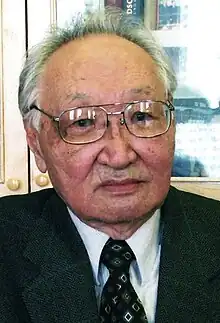
Shagdaryn Bira (September 1927 – 13 February 2022) was a Mongolian historian and scholar noted for his research that examines the history, culture, religion, and languages of the Mongols.[1][2][3] This research covers a wide area from ancient ties between Mongolia, India and Tibet to Genghis Khan's Mongolian Empire to Mongolian communism in the 20th century.[4][5][6][7]
From 1987, he served as the General Secretary for the International Association for Mongol Studies and worked as a visiting professor at universities and research institutes in several countries, including Russia, France, India, and Japan.[8][9] He wrote books, including the Mongolian Historiography in the 13th-17th Centuries, and contributed various chapters/volumes to UNESCO's History of Civilizations of Central Asia.[10][11][12][13][14][15]
Bira was one of founders and honorary president of the International Fund of Tengri Research, president of the Roerich Society of Mongolia, and director of the Nicholas Roerich Museum and Shambhala Art Institute.[16][17][18] He worked with Glenn Mullin to save the Roerich house in Mongolia and restore it as a museum and art gallery.[19][20][21] Bira was the oldest living student of George Roerich.[21]
In 2006 he was awarded the Fukuoka Prize.[9] Bira died on 13 February 2022, at the age of 94.[22]
References
- ↑ "Shagdaryn Bira - The 17th Fukuoka Asian Culture Prize : Academic Prize".
- ↑ "About the Expedition - Field Expedition: Mongolia, National Geographic". Archived from the original on 2016-06-08.
- ↑ Монгол Тулгатан (7 December 2015). "[Монгол Тулгатны 100 эрхэм] - Ш.Бира" – via YouTube.
- ↑ Jargal Dambadarjaa (17 November 2011). "Bira Shagdar" – via YouTube.
- ↑ "К изучению истории культа Тнгри у монголов".
- ↑ http://www.worldcat.org/identities/lccn-n84-35729/
- ↑ Lin, Albert Yu-Min (2012-03-12). "Globalization Through the Eyes of a Nomad". National Geographic (blogs). Archived from the original on March 14, 2012. Retrieved 2016-05-30.
- ↑ Wilford, John Noble (22 July 1991). "Buddha and Genghis Khan Back in Mongolia". The New York Times.
- 1 2 "Academic Prize 2006, Shagdaryn BIRA - Laureates - Fukuoka Prize". Fukuoka Prize.
- ↑ ""The Secret History of the Mongols" by Bira, Shagdaryn - UNESCO Courier, September 1989". Archived from the original on 2016-06-30. Retrieved 2016-05-29.
- ↑ http://www.unesco.org/culture/asia/html_eng/auteurs.htm#SH. BIRA
- ↑ Sanders, Alan J. K. (20 May 2010). Historical Dictionary of Mongolia. Scarecrow Press. ISBN 9780810874527.
- ↑ Elisseeff, Vadime (1 January 1998). The Silk Roads: Highways of Culture and Commerce. Berghahn Books. ISBN 9781571812223 – via Google Books.
- ↑ "Fukuoka Prize – Laureates" (PDF).
- ↑ Bira, Sh; Krueger, John R. (John Richard) (1 January 2002). Mongolian historical writing from 1200 to 1700 / Shagdaryn Bira ; translated from the original Russian by John R. Krueger and revised and updated by the author. Studies on East Asia. Center for East Asian Studies, Western Washington Universioty. ISBN 9780914584230 – via National Library of Australia.
- ↑ "Founders". International Fund of Tengri Research (in Russian). 23 November 2012. Retrieved 2020-01-15.
- ↑ "Roerich Shambhala Museum and Art Institute opens in Mongolia". Lion's Roar. 13 August 2009.
- ↑ glennmullin (30 July 2011). "Vol 7: Prof. S. Bira, Portrait of a Mongol Hero".
- ↑ "Roerich Mongolia Website".
- ↑ "Roerich Mongolia Website".
- 1 2 Watch, Theosophy (15 August 2014). "Land of Mystery: Roerich's Shambhala".
- ↑ "ЭМГЭНЭЛ: Шагдарын БИРА (1927–2022)". IKON. 15 February 2022. Retrieved 19 February 2022.